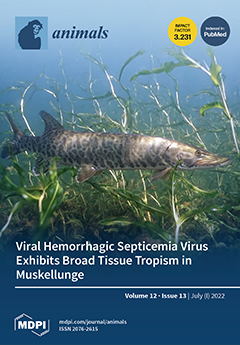Ticks transmit pathogens to animals and humans more often than any other arthropod vector. The rural economy of Pakistan mainly depends on livestock farming, and tick infestations cause severe problems in this sector. The present study aimed to molecularly characterize the
Anaplasma spp. in hard ticks collected from six districts of Khyber Pakhtunkhwa, Pakistan. Ticks were collected from various livestock hosts, including cattle breeds (Holstein-Friesian, Jersey, Sahiwal, and Achai), Asian water buffaloes, sheep, and goats from March 2018 to February 2019. Collected ticks were morphologically identified and subjected to molecular screening of
Anaplasma spp. by amplifying
16S rDNA sequences. Six hundred seventy-six ticks were collected from infested hosts (224/350, 64%). Among the nine morphologically identified tick species, the highest occurrence was noted for
Rhipicephalus microplus (254, 37.6%), followed by
Hyalomma anatolicum (136, 20.1%),
Rhipicephalus haemaphysaloides (119, 17.6%),
Rhipicephalus turanicus (116, 17.1%),
Haemaphysalis montgomeryi (14, 2.1%),
Hyalomma dromedarii (11, 1.6%),
Haemaphysalis bispinosa (10, 1.5%),
Hyalomma scupense (8, 1.2%), and
Haemaphysalis kashmirensis (8, 1.2%). The occurrence of tick females was highest (260, 38.5%), followed by nymphs (246, 36.4%) and males (170, 25.1%). Overall, the highest occurrence of ticks was recorded in the Peshawar district (239, 35.3%), followed by Mardan (183, 27.1%), Charsadda (110, 16.3%), Swat (52, 7.7%), Shangla (48, 7.1%), and Chitral (44, 6.5%). Among these ticks,
Anaplasma marginale was detected in
R. microplus,
R. turanicus, and
R. haemaphysaloides. The
16S rDNA sequences showed high identity (98–100%) with
A. marginale reported from Australia, China, Japan, Pakistan, Thailand, Uganda, and the USA. In phylogenetic analysis, the sequence of
A. marginale clustered with the same species reported from Australia, China, Pakistan, Thailand, Uruguay, and the USA. Further molecular work regarding the diversity of tick species and associated pathogens is essential across the country.
Full article






